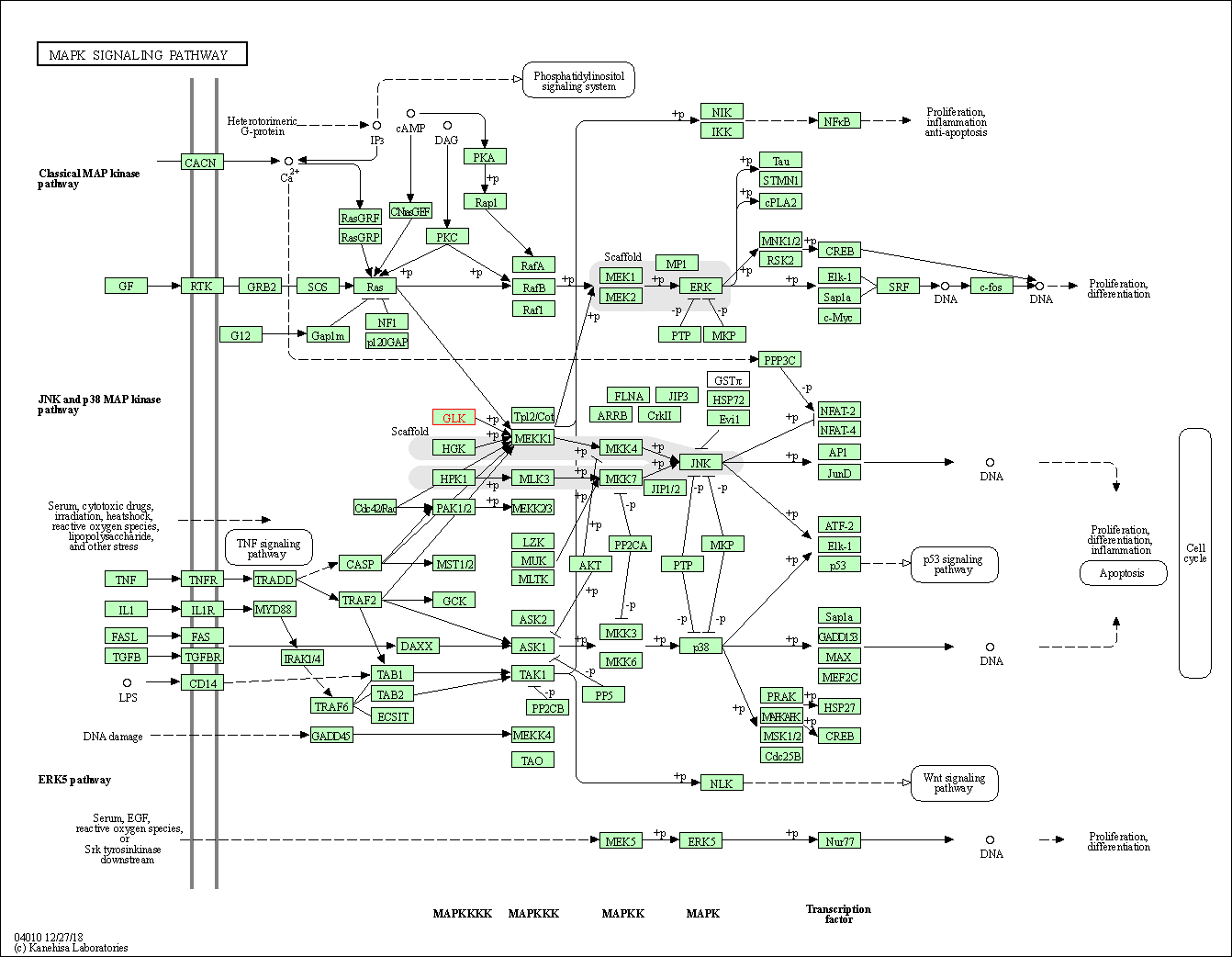Target Information
| Target General Information | Top | |||||
|---|---|---|---|---|---|---|
| Target ID |
T46000
(Former ID: TTDI03385)
|
|||||
| Target Name |
MEK kinase kinase 3 (MAP4K3)
|
|||||
| Synonyms |
RAB8IPL1; Mitogen-activated protein kinase kinase kinase kinase 3; MEKKK 3; MAPK/ERK kinase kinase kinase 3; Germinal center kinase-related protein kinase; GLK
Click to Show/Hide
|
|||||
| Gene Name |
MAP4K3
|
|||||
| Target Type |
Literature-reported target
|
[1] | ||||
| Function |
Appears to act upstream of the JUN N-terminal pathway. May play a role in the response to environmental stress.
Click to Show/Hide
|
|||||
| BioChemical Class |
Kinase
|
|||||
| UniProt ID | ||||||
| EC Number |
EC 2.7.11.1
|
|||||
| Sequence |
MNPGFDLSRRNPQEDFELIQRIGSGTYGDVYKARNVNTGELAAIKVIKLEPGEDFAVVQQ
EIIMMKDCKHPNIVAYFGSYLRRDKLWICMEFCGGGSLQDIYHVTGPLSELQIAYVSRET LQGLYYLHSKGKMHRDIKGANILLTDNGHVKLADFGVSAQITATIAKRKSFIGTPYWMAP EVAAVERKGGYNQLCDLWAVGITAIELAELQPPMFDLHPMRALFLMTKSNFQPPKLKDKM KWSNSFHHFVKMALTKNPKKRPTAEKLLQHPFVTQHLTRSLAIELLDKVNNPDHSTYHDF DDDDPEPLVAVPHRIHSTSRNVREEKTRSEITFGQVKFDPPLRKETEPHHELPDSDGFLD SSEEIYYTARSNLDLQLEYGQGHQGGYFLGANKSLLKSVEEELHQRGHVAHLEDDEGDDD ESKHSTLKAKIPPPLPPKPKSIFIPQEMHSTEDENQGTIKRCPMSGSPAKPSQVPPRPPP PRLPPHKPVALGNGMSSFQLNGERDGSLCQQQNEHRGTNLSRKEKKDVPKPISNGLPPTP KVHMGACFSKVFNGCPLKIHCASSWINPDTRDQYLIFGAEEGIYTLNLNELHETSMEQLF PRRCTWLYVMNNCLLSISGKASQLYSHNLPGLFDYARQMQKLPVAIPAHKLPDRILPRKF SVSAKIPETKWCQKCCVVRNPYTGHKYLCGALQTSIVLLEWVEPMQKFMLIKHIDFPIPC PLRMFEMLVVPEQEYPLVCVGVSRGRDFNQVVRFETVNPNSTSSWFTESDTPQTNVTHVT QLERDTILVCLDCCIKIVNLQGRLKSSRKLSSELTFDFQIESIVCLQDSVLAFWKHGMQG RSFRSNEVTQEISDSTRIFRLLGSDRVVVLESRPTDNPTANSNLYILAGHENSY Click to Show/Hide
|
|||||
| 3D Structure | Click to Show 3D Structure of This Target | AlphaFold | ||||
| Cell-based Target Expression Variations | Top | |||||
|---|---|---|---|---|---|---|
| Cell-based Target Expression Variations | ||||||
| Drug Binding Sites of Target | Top | |||||
|---|---|---|---|---|---|---|
| Ligand Name: Phosphonothreonine | Ligand Info | |||||
| Structure Description | GLK co-crystal structure with aminopyrrolopyrimidine inhibitor | PDB:5J5T | ||||
| Method | X-ray diffraction | Resolution | 2.85 Å | Mutation | Yes | [2] |
| PDB Sequence |
SQEDFELIQR
21 IGSGTYGDVY31 KARNVNTGEL41 AAIKVIKLEP51 GEDFAVVQQE61 IIMMKDCKHP 71 NIVAYFGSYL81 RRDKLWICME91 FCGGGSLQDI101 YHVTGPLSEL111 QIAYVSRETL 121 QGLYYLHSKG131 KMHRDIKGAN141 ILLDNGHVKL152 ADFGVSAQIT162 ATIAAFIGTP 175 YWMAPEVAAV185 ERKGGYNQLC195 DLWAVGITAI205 ELAELQPPMF215 DLHPMRALFL 225 MTKSNFQPPK235 LKDKMKWSNS245 FHHFVKMALT255 KNPKKRPTAE265 KLLQHPFVTQ 275 HLTRSLAIEL285 LDKVNNPSTY297 HDFDDDDPEP307 LVAVPHR
|
|||||
|
|
||||||
| Ligand Name: 5-[2-(Piperidin-4-Yl)-1,3-Thiazol-5-Yl]-3-[(Pyridin-4-Yl)methoxy]pyridin-2-Amine | Ligand Info | |||||
| Structure Description | GLK co-crystal structure with aminopyrrolopyrimidine inhibitor | PDB:5J5T | ||||
| Method | X-ray diffraction | Resolution | 2.85 Å | Mutation | Yes | [2] |
| PDB Sequence |
SQEDFELIQR
21 IGSGTYGDVY31 KARNVNTGEL41 AAIKVIKLEP51 GEDFAVVQQE61 IIMMKDCKHP 71 NIVAYFGSYL81 RRDKLWICME91 FCGGGSLQDI101 YHVTGPLSEL111 QIAYVSRETL 121 QGLYYLHSKG131 KMHRDIKGAN141 ILLDNGHVKL152 ADFGVSAQIT162 ATIAAFIGTP 175 YWMAPEVAAV185 ERKGGYNQLC195 DLWAVGITAI205 ELAELQPPMF215 DLHPMRALFL 225 MTKSNFQPPK235 LKDKMKWSNS245 FHHFVKMALT255 KNPKKRPTAE265 KLLQHPFVTQ 275 HLTRSLAIEL285 LDKVNNPSTY297 HDFDDDDPEP307 LVAVPHR
|
|||||
|
|
||||||
| Click to View More Binding Site Information of This Target with Different Ligands | ||||||
| Different Human System Profiles of Target | Top |
|---|---|
|
Human Similarity Proteins
of target is determined by comparing the sequence similarity of all human proteins with the target based on BLAST. The similarity proteins for a target are defined as the proteins with E-value < 0.005 and outside the protein families of the target.
A target that has fewer human similarity proteins outside its family is commonly regarded to possess a greater capacity to avoid undesired interactions and thus increase the possibility of finding successful drugs
(Brief Bioinform, 21: 649-662, 2020).
Human Tissue Distribution
of target is determined from a proteomics study that quantified more than 12,000 genes across 32 normal human tissues. Tissue Specificity (TS) score was used to define the enrichment of target across tissues.
The distribution of targets among different tissues or organs need to be taken into consideration when assessing the target druggability, as it is generally accepted that the wider the target distribution, the greater the concern over potential adverse effects
(Nat Rev Drug Discov, 20: 64-81, 2021).
Human Pathway Affiliation
of target is determined by the life-essential pathways provided on KEGG database. The target-affiliated pathways were defined based on the following two criteria (a) the pathways of the studied target should be life-essential for both healthy individuals and patients, and (b) the studied target should occupy an upstream position in the pathways and therefore had the ability to regulate biological function.
Targets involved in a fewer pathways have greater likelihood to be successfully developed, while those associated with more human pathways increase the chance of undesirable interferences with other human processes
(Pharmacol Rev, 58: 259-279, 2006).
Human Similarity Proteins
Human Tissue Distribution
Human Pathway Affiliation
|
|
|
Note:
If a protein has TS (tissue specficity) scores at least in one tissue >= 2.5, this protein is called tissue-enriched (including tissue-enriched-but-not-specific and tissue-specific). In the plots, the vertical lines are at thresholds 2.5 and 4.
|

| KEGG Pathway | Pathway ID | Affiliated Target | Pathway Map |
|---|---|---|---|
| MAPK signaling pathway | hsa04010 | Affiliated Target |

|
| Class: Environmental Information Processing => Signal transduction | Pathway Hierarchy | ||
| Chemical Structure based Activity Landscape of Target | Top |
|---|---|
| Target Regulators | Top | |||||
|---|---|---|---|---|---|---|
| Target-regulating microRNAs | ||||||
| Target-interacting Proteins | ||||||
| References | Top | |||||
|---|---|---|---|---|---|---|
| REF 1 | The design, synthesis, and biological evaluation of potent receptor tyrosine kinase inhibitors. Bioorg Med Chem Lett. 2012 Aug 1;22(15):4979-85. | |||||
| REF 2 | Germinal-center kinase-like kinase co-crystal structure reveals a swapped activation loop and C-terminal extension. Protein Sci. 2017 Feb;26(2):152-162. | |||||
If You Find Any Error in Data or Bug in Web Service, Please Kindly Report It to Dr. Zhou and Dr. Zhang.

